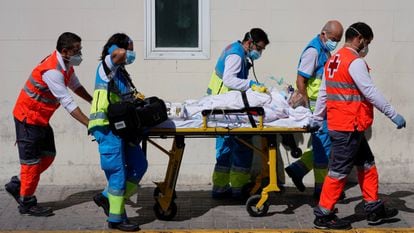Four areas of Spain’s Palma de Mallorca to be confined due to Covid-19
Authorities will restrict resident movement in these neighborhoods for at least 15 days to curb transmission
/cloudfront-eu-central-1.images.arcpublishing.com/prisa/HR3CNEH37BFSDATDVXWC4H7OPI.jpg)

Authorities will confine four neighborhoods in Palma, on the Spanish island of Mallorca, due to high coronavirus transmission rates in the city.
The areas of Son Gotleu, Can Capes, La Soledat Nord and part of Son Canals, which are home to nearly 23,000 people, will be closed off for at least 15 days beginning on Friday at 10pm. Residents will only be allowed in and out for essential business such as work, school and visits to the doctor.
Closing time for bars and restaurants is set at 10pm and all religious services, except for funerals, are being suspended. Public parks, sports arenas and gyms cannot open during the confinement period.
Community transmission in these neighborhoods is high, with 496 cases per 100,000 people, three times as much as the average for the entire island of Mallorca. The positivity rate is 18.1% of all tested cases.
Highest incidence in Western Europe
The Spanish Health Ministry reported 8,960 new coronavirus cases on Tuesday. According to the latest report, the number of new infections continues to rise, but at a less aggressive rate (in relative terms) than in July and August. It is too soon, however, to confirm whether the upward curve is stabilizing or might even start to fall again. Since the beginning of the pandemic, the Health Ministry has recorded a total of 534,513 Covid-19 cases.
Spain continues to be the Western European country with the highest cumulative incidence of the virus, with 236 cases per 100,000 inhabitants in the last 14 days. This is nearly double the rate in France (120), which has seen a spike in infections, and far higher than the figure in the United Kingdom (33.5), Portugal (44.7) and Germany (19.1).
Madrid is going to need a perimeter confinement and measures that require a state of alarmJosé Martínez Olmos, professor at the Andalusian Public Health School
On a national level, the Madrid region continues to report the largest number of cases, accounting for one third of all infections: 17,998 of the 52,1238 cases recorded in the last week. It also is the region with the highest incidence rate of Covid-19 with 543 cases per 100,000 people, followed by La Rioja (392.6), Basque Country (372) and Navarre (364).
The Spanish regions with the lowest incidence of the virus are Asturias (60), Galicia (128), Andalusia (129) and Catalonia (180). At the beginning of the second wave, Catalonia was one of the regions with the highest number of new coronavirus cases, but now has a lower 14-day cumulative rate than the national average (236).
A total of 575 new patients were hospitalized with Covid-19, and 49 were admitted into intensive care, according to the Health Ministry report released on Tuesday. This document recorded 78 new coronavirus fatalities, bringing the official total to 29,594, although the real number is likely to be much higher as thousands of people died during the pandemic without being diagnosed.
Madrid hospitals feel the strain
The number of hospital beds occupied by coronavirus patients in the Madrid region has doubled in three weeks. If the regional government’s new restrictions on social activities fail to curb contagion, some hospitals in the region may be overwhelmed within weeks, experts warn.
On August 20, the first day that the central Health Ministry published figures on hospital occupancy, coronavirus patients made up 9.4% of admissions. On September 8, that figure was 19%. The spike in the number of Covid-19 patients in intensive care units (ICUs) has been even more significant, rising from 126 to 288. This rise is above the average in Spain, where hospital occupancy has increased from 4.3% to 7.4%, and the number of ICU patients has gone from 522 to 1,051, according to the Health Ministry report from Monday.

Although the Madrid regional government believes the situation is “under control,” the rise in coronavirus cases has increased pressure on Madrid hospitals, some of which have had to transfer patients to other medical centers. As of Tuesday, the Madrid region had 2,139 coronavirus patients in hospital, 275 of whom were in the ICU.
According to Manuel de Castro, from the Madrid Doctors and Advanced Degree Association, hospitals under the greatest strain are already postponing non-urgent surgeries to ensure ICUs are not compromised. What’s more, resources meant to be used for other reasons are being set aside for Covid-19 patients.
José Martínez Olmos, who teaches at the Andalusian Public Health School and served as a health official for the Spanish government between 2005 and 2011, warns the new restrictions on social gatherings will not be enough to curb transmission. “In my opinion, Madrid is going to need a perimeter confinement and measures that require a state of alarm,” he said. “If the expected outbreaks in schools increase the incidence [of the virus] and if there are outbreaks in senior residences that could potentially hurt the health of the seniors, this will lead to more pressure on hospitals and an increase in mortality.”
English version by Melissa Kitson.
/cloudfront-eu-central-1.images.arcpublishing.com/prisa/L5676WHDPVHHJD2UBWYUYPY7GQ.aspx)
/cloudfront-eu-central-1.images.arcpublishing.com/prisa/REHVRFA2AVDTZHIVUBUCUGENQI.jpg)










































